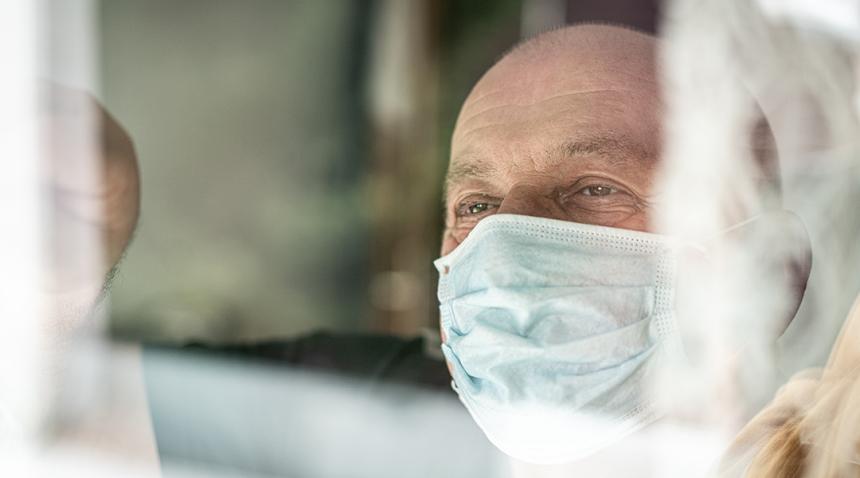Types of Face Coverings for COVID-19 Protection

After months of telling everyone that only the sick needed to wear protective face masks, the Centers for Disease Control and Prevention switch course on April 3 and announced that people should wear masks when they are in public.
Why the sudden change? New evidence suggests that people without symptoms of COVID-19 may be spreading the disease. The new policy aims to protect the unexposed from people with symptoms and without.
How Face Masks Work
Some face masks are designed to filter out microscopic bacterial and viral particles. There are significant differences between bacteria and viruses — bacteria are living, one cell organisms that can replicate and cause disease. They’re about 1,000 nm in size, which is roughly one-millionth of meter. Viruses fall into a gray area between living and non-living particles and require a host to replicate. And viral microbes also are much smaller. For instance, influenza viral particles range between 80 and 100 nm, and COVID-19 particles are 125 nm, much smaller than bacteria. These differences make it necessary to use different types of masks for protection.
Types of Face Masks
Mask fall into three basic categories -- surgical, surgical N95 respirator and homemade. Each have pros and cons.
Surgical Masks 
Surgical masks, commonly worn by healthcare workers, are intended to block bacterial germs transmitted through secretions, sprays, splashes and large-particle droplets from entering the mouth or nose. They’re disposable, loose-fitting and cover the nose, mouth and chin and should be thrown away after using them. You can easily recognize them by their design: flat, rectangular shaped with pleats, a metal strip along the nose area and long straight ties. Although they’re easy to wear and effective, they’re not able to filter most viral particles.
Surgical N95 Respirator Masks
 These circular or oval-shaped masks are designed to form a seal around your face, fitting much tighter than surgical masks. In fact, they come in different sizes to ensure the wearer has a tight seal. And these masks aren’t as disposable as surgical masks; you can continue using them as long as they form a seal. Facial hair may interfere with the mask forming a tight seal.
These circular or oval-shaped masks are designed to form a seal around your face, fitting much tighter than surgical masks. In fact, they come in different sizes to ensure the wearer has a tight seal. And these masks aren’t as disposable as surgical masks; you can continue using them as long as they form a seal. Facial hair may interfere with the mask forming a tight seal.
Like surgical masks, they protect against germs contained in secretions, splashes and sprays and large droplets. But they’re able to filter out about 95 percent very small particles such as viral microbes.
However, there are downsides to N95 respirator masks. For instance, it’s difficult to breath while wearing them. Some of these masks include an exhalation valve, making it easier for the wearer to breath; some people still find it difficult. They’re also not mass produced like surgical masks (because healthcare workers usually don’t use them), which can make them difficult to purchase. There are major shortages in the U.S.
Facial movements such as laughing, yawning and coughing can break the seal, leaving your vulnerable to germ transmission, according to Fast Company. As of now, the Centers for Disease Control and Prevention does not recommend wearing N95 respirators to protect against COVID-19.
Homemade Masks
 Some people have resorted to making their own masks. Materials commonly used include anti-microbial linens and jersey. While studies suggest that homemade masks are not as effective as N95 masks or even surgical masks, they might have some benefits. For example, placing a jersey mask on a person infected with COVID-19 could lower their risk of spreading germs.
Some people have resorted to making their own masks. Materials commonly used include anti-microbial linens and jersey. While studies suggest that homemade masks are not as effective as N95 masks or even surgical masks, they might have some benefits. For example, placing a jersey mask on a person infected with COVID-19 could lower their risk of spreading germs.
The CDC still considers the best way to control the spread of COVID-19 is to wash your hands frequently with soap and water or an alcohol-based hand sanitizer, practice social distancing, cover your coughs and sneezes, stay home if you’re not feeling well and disinfect surfaces and objects on a regular basis. If you have questions regarding coronavirus, call your doctor or local health department.


